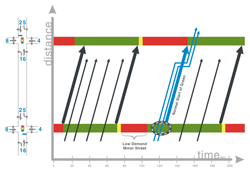The Chapters
Policy and Funding Considerations
This chapter provides a summary of signal timing policy development, along with policy examples, and an overview of the signal timing process and its interactions with policy. There is a discussion of various funding considerations and sources for signal timing, as well as example programs that have effectively coordinated signal timing, policy, and performance measures.
Operational and Safety Analysis
This chapter provides a summary of the common techniques to assess the operational and safety performance of signal timing. It discusses planning-level analyses, as well as more detailed performance measures, and analysis techniques. It presents general information on signal timing analysis models, safety needs assessments, and the Manual on Uniform Traffic Control Devices (MUTCD) Traffic Signal Warrants.

Traffic Signal Design
This chapter documents the principles of traffic signal design and the relationship to traffic signal timing, including signal control type, signal phasing, detection layout, and how traffic signal design affects isolated and coordinated signal timing operations. It discusses the objectives of traffic signal design, concepts, procedures and guidelines.

Basic Signal Timing Controller Parameters
This chapter presents basic traffic signal timing principles for a single intersection, operating with and without coordination. The chapter presents an overview of basic signal timing parameters and terminology used in traffic signal controllers, and defines the signal timing settings and their applications. It also describes the procedure to develop safe and efficient intersection operations through signal timing.
Developing Coordinated Signal Timing Plans

These chapters present and define the concept of coordinating traffic signals, and provides examples from research and practice. They provide a summary of objectives, the fundamental concepts, and expectations of coordinated timing. They describe the concepts for coordination, its effect on time allocation, implementation issues, time-space diagrams. The second chapter documents the process to develop coordinated signal timing plans in a step-by-step fashion. It provides an overview of coordination, the concepts for coordination, coordination’s effect on time allocation at the signalized intersection, data collection procedures, and performance measures used in a traffic signal retiming effort.
Maintenance Operations and Monitoring
This chapter provides a summary of the various steps necessary to maintain effective traffic signal timing plans and corresponding activities. This chapter presents a checklist of typical events (public complaints, weather, etc.) and the range of possible responses, with cross-references to the appropriate chapters in the manual. Common questions and answers are provided that can assist personnel involved in direct communication with the public. Finally, this chapter highlights issues raised during the ITE traffic signal self-assessment and communicates recommended staffing levels for public agency jurisdictions.
Advanced Signal Timing Topics

This chapter introduces some advanced concepts and applications within signal timing. Topics presented in this chapter include traffic signal preemption, traffic signal priority, transition logic, traffic responsive operation, adaptive traffic signal control, planned special event, incident, and emergency-management and weather-related factors that influence signal timing.





